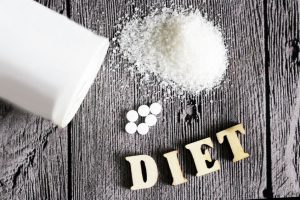
Splenda® marketers are really crafty, and actually, very smart. They label their chemical sugar-substitute to sound like it’s sugar, so if you look at the ingredients quickly, you might not notice the difference. Sucralose looks and sounds like sucrose. But there is a HUGE difference.
Sucralose is Splenda, a laboratory sugar that has been altered in the lab to be 75% chlorine.
Sucrose is a naturally occurring disaccharide of glucose and fructose. It’s commonly known as “table sugar” but it can be found naturally in fruits, vegetables, and nuts. Sucralose, on the other hand, is an artificial sweetener man-made using all kinds of chemicals.
Sucralose is made in a lab.
Here’s Splenda’s chemical formula: 1,6-dichloro-1, 6-dideoxy-BETA-D-fructofuranosyl-4-chloro-4-deoxy-alpha-D-galactopyranoside. Are they trying to trick us into thinking sucralose is sucrose?
Splenda is marketed as merely a benign sugar with a touch of chlorine, but you might disagree when you read the other side of this equation.

Using a complex process involving dozens of chemicals that you and I can barely pronounce – let alone should consume – I have listed below the actual process for producing this diet chemical sweetener. I highlighted the “chemicals used” in bold, and details about this formula are found in my book Splenda®: Is It Safe Or Not?
According to the Splenda International Patent A23L001-236 and PEP Review #90-1-4 (July 1991), sucralose is synthesized by this five-step process:
1. sucrose is tritylated with trityl chloride in the presence of dimethylformamide and 4–methylmorpholine and the tritylated sucrose is then acetylated with acetic anhydride,
2. the resulting TRISPA (6,1′,6′-tri-O-trityl-penta-O-acetylsucrose) is chlorinated with hydrogen chloride in the presence of toluene,
3. the resulting 4-PAS (sucrose 2,3,4,3′,4′-pentaacetate) is heated in the presence of methyl isobutyl ketone and acetic acid,
4. the resulting 6-PAS (sucrose 2,3,6,3′,4′-pentaacetate) is chlorinated with thionyl chloride in the presence of toluene and benzyltriethylammonium chloride, and
5. the resulting TOSPA (sucralose pentaacetate) is treated with methanol (wood alcohol, a poison) in the presence of sodium methoxide to produce sucralose.

The Hidden Chemicals in Splenda
Let’s sum this up … the chemicals used to synthesize sucralose in the five-step process (above) are more than just simple benign sugar with a touch of chlorine. The chemicals used to make sucralose (Splenda) are:
- Acetone
- Acetic acid
- Acetyl alcohol
- Acetic anhydride
- Ammonium chloride
- Benzene
- Chlorinated sulfates
- Ethyl alcohol
- Isobutyl ketones
- Formaldehyde
- Hydrogen chloride
- Lithium chloride
- Methanol
- Sodium methoxide
- Sulfuryl chloride
- Trityl chloride
- Toluene
- Thionyl chloride
If you want to investigate the health symptoms caused by sucralose, simply research the side effects of each of these chemicals. That’s how you know.
There is no free ticket to eating all the sugar-free products you want without paying the price of harming your body in the long run. Laboratory chemicals are not the sugar-free solution to health and wellness.
It certainly doesn’t sound very appetizing to me.
_______________
If you want to learn more about healthy living and disease prevention, contact me at janethull.com. Remember that you are never alone when you are looking for good health!
Join me on my weekly radio/tv show on Healthy Alternatives, and click https://janethull.com/healthyalternatives to get notified when new shows air.
Gain access to all of my online programs, ongoing support, monthly Q&A, and more by joining me on janethull.com. I look forward to supporting you on your journey to alternative health and wellness.
_____________
Disclaimer: This article is for informational purposes only, and is educational in nature. The FDA may not have evaluated some of the statements. This article is not intended to diagnose, treat, cure, or prevent any disease. Please discuss with your own, qualified health care provider before adding supplements or making any changes to your dietary program.
Before taking vitamins, consult your doctor; pre-existing medical conditions or medications you are taking can affect how your body responds to multivitamins.
You have our permission to reprint this article if you attribute us with a live back-link to this article and the youtube links. http://www.janethull.com/
INFORMATION ON THIS WEB SITE IS PROVIDED FOR INFORMATIONAL AND EDUCATIONAL PURPOSES ONLY. THE INFORMATION IS A RESULT OF YEARS OF PRACTICE EXPERIENCE BY THE AUTHOR. THIS INFORMATION IS NOT INTENDED AS A SUBSTITUTE FOR THE ADVICE PROVIDED BY YOUR PHYSICIAN OR OTHER HEALTHCARE PROFESSIONAL OR ANY INFORMATION CONTAINED ON OR IN ANY PRODUCT LABEL OR PACKAGING. DO NOT USE THE INFORMATION ON THIS WEB SITE FOR DIAGNOSING OR TREATING A HEALTH PROBLEM OR DISEASE, OR PRESCRIBING MEDICATION OR OTHER TREATMENT. ALWAYS SPEAK WITH YOUR PHYSICIAN OR OTHER HEALTHCARE PROFESSIONAL BEFORE TAKING ANY MEDICATION OR NUTRITIONAL, HERBAL OR HOMEOPATHIC SUPPLEMENT, OR USING ANY TREATMENT FOR A HEALTH PROBLEM. IF YOU HAVE OR SUSPECT THAT YOU HAVE A MEDICAL PROBLEM, CONTACT YOUR HEALTH CARE PROVIDER IMMEDIATELY. DO NOT DISREGARD PROFESSIONAL MEDICAL ADVICE OR DELAY IN SEEKING PROFESSIONAL ADVICE BECAUSE OF SOMETHING YOU HAVE READ ON THIS WEB SITE. INFORMATION PROVIDED ON THIS WEB SITE AND THE USE OF ANY PRODUCTS OR SERVICES PURCHASED FROM OUR WEB SITE BY YOU DOES NOT CREATE A DOCTOR-PATIENT RELATIONSHIP BETWEEN YOU AND ANY OF THE PHYSICIANS AFFILIATED WITH OUR WEB SITE. INFORMATION AND STATEMENTS REGARDING DIETARY SUPPLEMENTS HAVE NOT BEEN EVALUATED BY THE FOOD AND DRUG ADMINISTRATION AND ARE NOT INTENDED TO DIAGNOSE, TREAT, CURE, OR PREVENT ANY DISEASE AND SERVE ONLY AS EDUCATIONAL
_______________